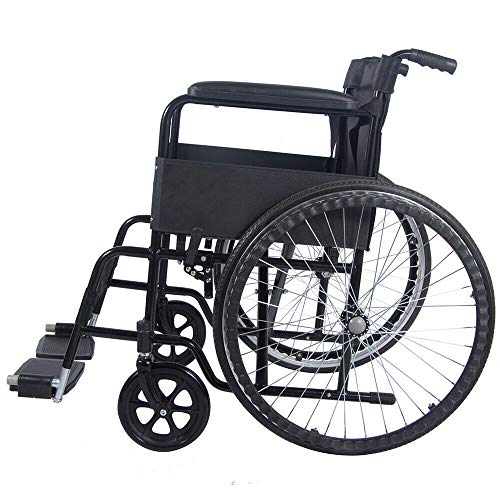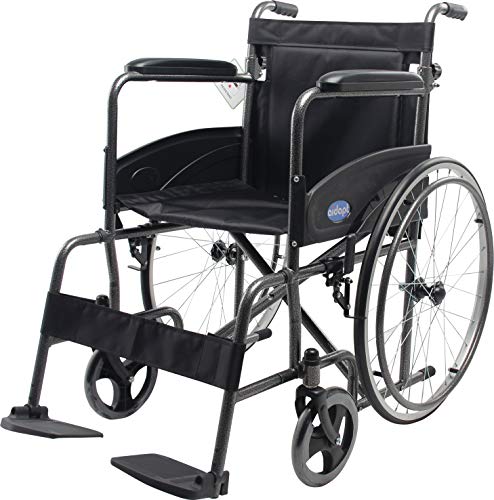See What Self Control Wheelchair Tricks The Celebs Are Using
мһ‘м„ұмқј 24-11-12 02:49
нҺҳмқҙм§Җ м •ліҙ
мһ‘м„ұмһҗJustin Fosbery мЎ°нҡҢ 4нҡҢ лҢ“кёҖ 0кұҙліёл¬ё
 Types of self propelled wheelchairs lightweight Control Wheelchairs
Types of self propelled wheelchairs lightweight Control WheelchairsMany people with disabilities use self propelled wheelchair with attendant brakes control wheelchairs to get around. These chairs are great for everyday mobility and are able to easily climb hills and other obstacles. They also have huge rear flat free shock absorbent nylon tires.
The velocity of translation for wheelchairs was calculated using a local field potential approach. Each feature vector was fed to an Gaussian decoder that outputs a discrete probability distribution. The accumulated evidence was used to trigger the visual feedback and a signal was issued when the threshold was attained.
Wheelchairs with hand rims
The type of wheels that a wheelchair has can affect its maneuverability and ability to traverse various terrains. Wheels with hand rims can help relieve wrist strain and improve comfort for the user. Wheel rims for wheelchairs are available in steel, aluminum, plastic or other materials. They also come in a variety of sizes. They can also be coated with vinyl or rubber for improved grip. Some are equipped with ergonomic features such as being designed to fit the user's natural closed grip and having wide surfaces for all-hand contact. This allows them distribute pressure more evenly, and prevents fingertip pressing.
A recent study found that flexible hand rims reduce impact forces and the flexors of the wrist and fingers during wheelchair propulsion. These rims also have a larger gripping area than tubular rims that are standard. This lets the user apply less pressure, while ensuring excellent push rim stability and control. These rims are available at a wide range of online retailers as well as DME providers.
The results of the study revealed that 90% of those who used the rims were pleased with the rims. However it is important to keep in mind that this was a mail survey of people who purchased the hand rims from Three Rivers Holdings and did not necessarily represent all wheelchair users suffering from SCI. The survey didn't measure any actual changes in pain levels or symptoms. It only measured the extent to which people noticed an improvement.
The rims are available in four different models, including the light, big, medium and prime. The light is a round rim with smaller diameter, and the oval-shaped medium and large are also available. The prime rims have a larger diameter and an ergonomically contoured gripping area. All of these rims are placed on the front of the wheelchair and are purchased in various colors, from natural -which is a light tan shade -- to flashy blue, green, red, pink or jet black. They are also quick-release and can be easily removed to clean or maintain. The rims have a protective vinyl or rubber coating to prevent the hands from slipping and causing discomfort.
Wheelchairs with tongue drive
Researchers at Georgia Tech have developed a new system that lets users maneuver a wheelchair and control other electronic devices by moving their tongues. It is comprised of a small magnetic tongue stud, which transmits signals for movement to a headset with wireless sensors as well as a mobile phone. The phone converts the signals to commands that control a device such as a wheelchair. The prototype was tested by able-bodied people and spinal cord injury patients in clinical trials.
To test the effectiveness of this system, a group of physically able people utilized it to perform tasks that assessed input speed and accuracy. They completed tasks that were based on Fitts law, which includes the use of mouse and keyboard, and a maze navigation task with both the TDS and the normal joystick. A red emergency stop button was built into the prototype, and a second was present to help users press the button when needed. The TDS worked just as well as a normal joystick.
In another test, the TDS was compared to the sip and puff system. This allows people with tetraplegia to control their electric wheelchairs by sucking or blowing into a straw. The TDS was able of performing tasks three times faster and with more precision than the sip-and-puff. In fact, the TDS could drive a wheelchair with greater precision than even a person with tetraplegia who controls their chair using a specialized joystick.
The TDS could monitor tongue position to a precise level of less than one millimeter. It also came with cameras that could record eye movements of an individual to identify and interpret their movements. Software safety features were included, which verified the validity of inputs from users twenty times per second. If a valid signal from a user for UI direction control was not received for 100 milliseconds, the interface modules automatically stopped the wheelchair.
The team's next steps include testing the TDS on people who have severe disabilities. They have partnered with the Shepherd Center located in Atlanta, a catastrophic care hospital and the Christopher and Dana Reeve Foundation to conduct the tests. They intend to improve their system's tolerance for ambient lighting conditions, and to include additional camera systems, and to enable the repositioning of seats.
Wheelchairs with a joystick
With a power wheelchair that comes with a joystick, users can operate their mobility device with their hands, without having to use their arms. It can be positioned in the middle of the drive unit or on either side. It is also available with a screen to display information to the user. Some screens are large and backlit to make them more visible. Some screens are smaller, and some may include pictures or symbols that can help the user. The joystick can be adjusted to suit different hand sizes grips, sizes and distances between the buttons.
As the technology for power wheelchairs advanced, clinicians were able to develop alternative driver controls that allowed patients to maximize their functional capabilities. These advances also allow them to do so in a manner that is comfortable for the user.
For instance, a typical joystick is an input device which uses the amount of deflection in its gimble to produce an output that grows when you push it. This is similar to how automobile accelerator pedals or video game controllers function. This system requires strong motor skills, proprioception, and finger strength in order to work effectively.
A tongue drive system is a different kind of control that makes use of the position of a person's mouth to determine the direction to steer. A magnetic tongue stud sends this information to a headset which executes up to six commands. It is suitable to assist people suffering from tetraplegia or quadriplegia.
Certain alternative controls are simpler to use than the standard joystick. This is especially beneficial for people with limited strength or finger movement. Certain controls can be operated by only one finger which is perfect for those who have limited or no movement in their hands.
Additionally, certain control systems have multiple profiles which can be adapted to the specific needs of each customer. This is crucial for those who are new to the system and may require adjustments to their settings regularly when they are feeling tired or are experiencing a flare-up of a disease. This is useful for experienced users who want to alter the parameters set up for a specific environment or activity.
Wheelchairs with a steering wheel
Self-propelled wheelchairs are made for those who need to move around on flat surfaces as well as up small hills. They have large wheels on the rear to allow the user's grip to propel themselves. Hand rims enable the user to use their upper-body strength and mobility to guide a wheelchair forward or backwards. self propelled wheelchair ebay control wheelchair (Related Home Page)-propelled chairs are able to be fitted with a variety of accessories like seatbelts as well as armrests that drop down. They also come with legrests that swing away. Certain models can be converted to Attendant Controlled Wheelchairs, which permit caregivers and family to drive and control wheelchairs for people who require more assistance.
To determine kinematic parameters, participants' wheelchairs were fitted with three sensors that monitored movement over the course of an entire week. The distances measured by the wheels were determined by using the gyroscopic sensor that was attached to the frame and the one mounted on wheels. To distinguish between straight forward movements and turns, periods where the velocities of the right and left wheels differed by less than 0.05 milliseconds were deemed to be straight. Turns were further studied in the remaining segments, and the turning angles and radii were derived from the wheeled path that was reconstructed.
This study included 14 participants. The participants were evaluated on their navigation accuracy and command time. They were asked to navigate a wheelchair through four different wayspoints in an ecological field. During navigation tests, sensors monitored the wheelchair's trajectory across the entire course. Each trial was repeated at least two times. After each trial, participants were asked to select which direction the wheelchair to move in.
 The results showed that a majority of participants were able to complete the tasks of navigation even although they could not always follow the correct direction. They completed 47 percent of their turns correctly. The remaining 23% either stopped immediately after the turn, or redirected into a second turning, or replaced by another straight motion. These results are similar to those from previous studies.
The results showed that a majority of participants were able to complete the tasks of navigation even although they could not always follow the correct direction. They completed 47 percent of their turns correctly. The remaining 23% either stopped immediately after the turn, or redirected into a second turning, or replaced by another straight motion. These results are similar to those from previous studies.лҢ“кёҖлӘ©лЎқ
л“ұлЎқлҗң лҢ“кёҖмқҙ м—ҶмҠөлӢҲлӢӨ.